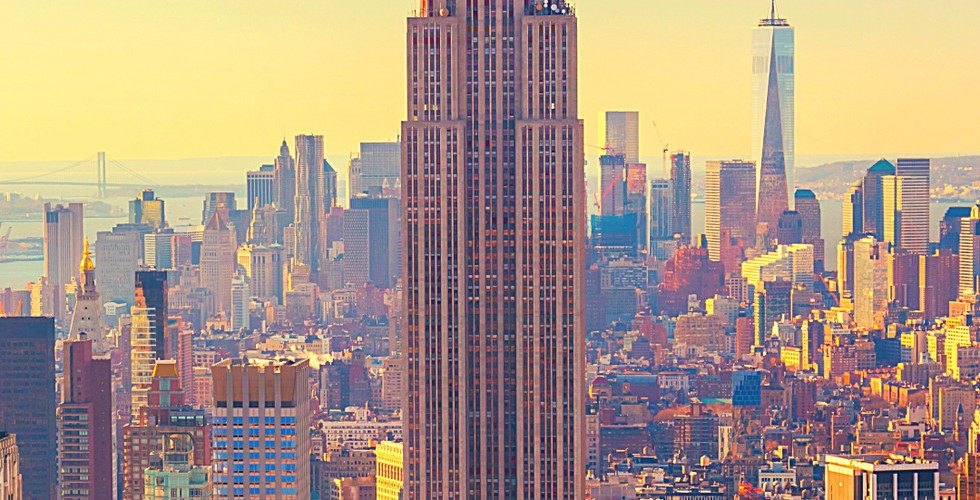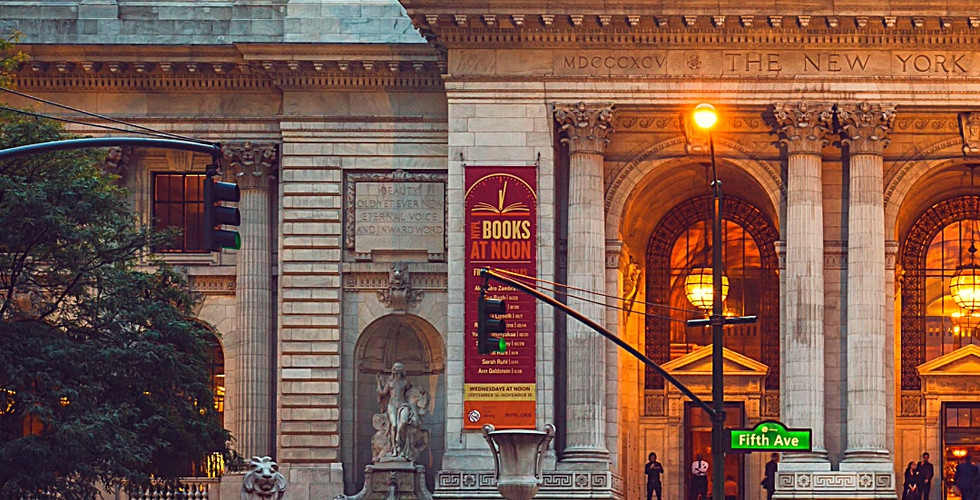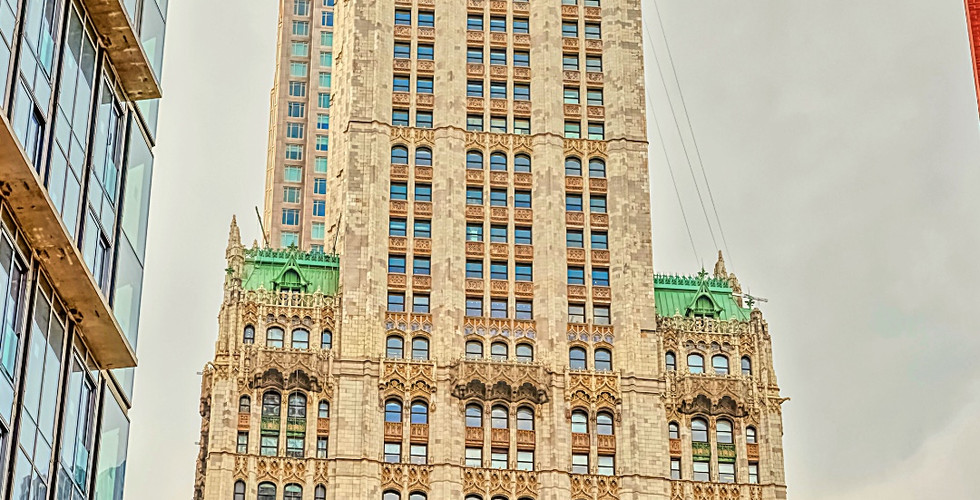10 Famous Buildings in New York: A guide by a backpacking Architect
- Apr 9
- 11 min read
Updated: 6 days ago
The infamous architecture of New York New York! We are doing my top 10 picks here on Backpackers Blueprint, the blog of a backpacking architect (hello its me Jack 🙌), helping you explorer famous buildings in New York lets go.

New York City is the epicentre of American Architecture and it is as Iconic as they come. It is an evolving and complex city with modern challenges like the impact of rising sea levels, it is also the site of one of the most hostile urban planing moves ever seen. The creation of central park! It has been a victim of its own success with high levels of poverty and poor build quality and has (and is) on the edge of modern design. Love it or hate it and even if you have never been, you likely have an idea of what New York looks like in your minds eye, more so than any other city in the world!
In this guide, I’ll take you through ten of the most famous buildings in New York City, dissecting their history, design, and symbolism.
You’ll also find my personal recommendations on where to stay ranging from budget hostels to luxurious retreats and what to explore around each landmark, and of course, regular Backpackers Blueprint readers will know I always suggest one thing above all others when visiting a city ... take a free walking tour with Guru, It has some great options for a multitude of areas in New York, take one take em alllll. Right, Let’s dive into the city that never sleeps starting with perhaps the most Iconic of them all ...
No.1. Empire State Building
Year Built: 1931
Style: Art Deco
Architect: Shreve, Lamb & Harmon
Entry Fee: General admission is around $44 for adults (includes observatory access) - Tickets from official website
Architecture Rating: 🏛️🏛️🏛️🏛️
Interior Design Rating: 🎨🎨🎨
Why It’s Special
The Empire State Building isn’t just a skyscraper; it’s an American icon that epitomises the optimism and grandeur of the early 20th century. Standing at 1,454 feet tall (including its antenna), this Art Deco masterpiece was the tallest building in the world for nearly 40 years. Its sleek, vertical lines, intricate setbacks, and bold ornamentation speak to a time when architects dared to dream big. The building manages to command the skyline, acting as a beacon of ambition for New Yorkers and visitors alike.
What to Explore
The Observatory: Take in panoramic views of Manhattan from the 86th and 102nd-floor observatories; an absolute must for any visitor.
Nighttime Illumination: Visit after sunset to see the building light up in different colours, often reflecting current events or seasonal themes.
Historical Exhibits: Check out the exhibits on the ground floor that detail the building’s fascinating construction history and cultural impact.
No.2. Chrysler Building
Year Built: 1930
Style: Art Deco
Architect: William Van Alen
Entry Fee: Viewing from the outside is free; interior tours are rare and typically not open to the public
Architecture Rating: 🏛️🏛️🏛️🏛️
Interior Design Rating: 🎨🎨🎨
Why It’s Special
The Chrysler Building is a glittering example of Art Deco design and remains one of the most beloved skyscrapers in NYC. Its distinctive spire, adorned with stainless steel cladding and eagles, looks almost futuristic against the New York skyline. I love how the building’s ornamentation; ranging from hubcaps to automotive motifs; celebrates the spirit of innovation that defined the 1930s. Despite its relatively short lifespan as the world’s tallest building, its influence on modern skyscraper design is immeasurable. Also ... its Art Deco ... so ... you know ... bea.utiful. I did a quick short on Youtube on the the Art Deco of Miami, check it out is you want to know more about art deco in around 45 seconds flat Miami Art Deco
What to Explore
Exterior Photography: The best way to appreciate the Chrysler Building is from the street. I recommend heading to the intersection of 42nd Street and Lexington Avenue for a perfect shot.
Architectural Details: Take time to examine the intricate metalwork on the spire and the unique ornamentation inspired by the automotive industry.
Historical Context: Learn about how the building was a symbol of modernity during the Great Depression; a testament to resilience and design innovation.
No.3. Flatiron Building
Year Built: 1902
Style: Beaux-Arts/Chicago School
Architect: Daniel Burnham
Entry Fee: Not applicable (external viewing only)
Architecture Rating: 🏛️🏛️🏛️🏛️
Interior Design Rating: 🎨🎨🎨
Why It’s Special
The Flatiron Building is one of NYC’s most instantly recognisable structures, thanks to its unique triangular shape that seems to defy gravity. Originally designed as a practical solution to an oddly shaped plot, its Beaux-Arts and Chicago School influences shine through in the building’s elegant façade and harmonious proportions. For me, it’s a reminder that necessity and creativity can combine to produce something truly iconic; even if it wasn’t initially designed with grandeur in mind, that or you know ... a beautiful wedge of cheese!
What to Explore
Photo Opportunities: The building’s narrow profile makes for amazing perspective shots. Capture it from across Madison Square Park for a classic view.
Historical Tours: Learn about how the Flatiron influenced urban design in the early 1900s and how it remains a fixture in NYC’s architectural narrative.
Surrounding Neighbourhood: Explore nearby Madison Square Park and the bustling Flatiron District, where history and modernity collide.
No.4. One World Trade Center

Year Built: 2013
Style: Contemporary / Modern
Architect: Skidmore, Owings & Merrill (SOM)
Entry Fee: Around $38 for general admission to the observatory again tickets can be bought from the official page
Architecture Rating: 🏛️🏛️
Interior Design Rating: 🎨🎨
Why It’s Special
One World Trade Center, also known as Freedom Tower, rises as a powerful symbol of resilience and renewal in the wake of tragedy. Its sleek, modern design contrasts sharply with the historical weight of its location. It’s a living memorial that represents hope, strength, and the enduring spirit of New York City. Its reflective glass façade and symbolic spire, reaching toward the heavens, serve as a beacon of progress and remembrance. Is it the most beautiful tower ever built, absolutely not which is why I have only given it an architecture rating of 2 (🏛️🏛️), but given what it represents its importance should not be overlooked.
What to Explore
The Observatory: Experience breathtaking views from the top floors. It’s both a technical marvel and an emotional experience.
The Memorial: Visit the 9/11 Memorial nearby to understand the building’s profound context within New York’s modern history.
Architectural Details: Notice the interplay of light and shadow on the façade, a modern reinterpretation of classic skyscraper design principles.
No.5. Solomon R. Guggenheim Museum
Year Built: 1959
Style: Modernist
Architect: Frank Lloyd Wright (FLW)
Entry Fee: Approximately $25 for adults from Official Guggenheim site
Architecture Rating: 🏛️🏛️🏛️🏛️🏛️
Interior Design Rating: 🎨🎨🎨🎨🎨
Why It’s Special
2 x 5/5 ratings, is this guy joking or what! Look I get it, perhaps an unpopular opinion but ... the Guggenheim Museum is not just a museum; it’s a revolutionary piece of architecture that changed the way we experience art and architecture.
Designed by one of the all time greats, Frank Lloyd Wright, its spiralling ramp and organic curves create an almost hypnotic interior flow that encourages visitors to engage with art in a continuous, unbroken journey. For me thought, the magic is the external massing and geometry. FLW wanted something profoundly different, something that challenged the tall plot filling buildings we see spring up, where maximum square footage and height are the only things that matter. Its something we see all to often in modern high rise architecture.
I am going to say it as I mean it ... greed takes precedent over the unique thought provoking buildings, the solomon R Guggenheim challenges this to its very core. I do not want to go too deep into this here but please drop a note in the comments if your really love, or hate this building and let me know why. But for me (not only as an art deco lover) but also as a lover of individualism and self expression; there are few buildings across New York, maybe across the globe that do it better. FLW was a total genius at getting us, as the public, to look more deeply at not just his building, but its position in the surrounding context. This can further lead to more profound questions beyond architecture and into culture and the world at large.
What to Explore
The Rotunda: The heart of the museum is its circular ramp; a continuous gallery that offers a unique perspective on art and design.
Exhibitions: While the building is a masterpiece on its own, the rotating exhibits add layers of cultural context and artistic dialogue.
Architectural Tours: Look for guided tours that delve into Wright’s design philosophy and the innovative construction techniques used in the building. Take your time to look at the building from the outside and ask yourself does this building belong here. Once you do, you will never view architecture in the same way again!
No.6. New York Public Library, Stephen A. Schwarzman Building
Year Built: 1911
Style: Beaux-Arts
Architect: Carrère and Hastings
Entry Fee: Free for visitors (yay)
Architecture Rating: 🏛️🏛️🏛️🏛️
Interior Design Rating: 🎨🎨🎨🎨
Why It’s Special
The New York Public Library’s Stephen A. Schwarzman Building is a monumental tribute to knowledge and art. Its ornate Beaux-Arts design, complete with marble columns, intricate carvings, and majestic staircases, exudes grandeur and timeless elegance. Its a very rich piece of architecture in an unlikely location and for that reason a great one to explore. This building would not be out of place in Rome.
What to Explore
The Rose Main Reading Room: One of the largest and most awe-inspiring reading rooms in the world.
Architectural Details: Study the elaborate sculptures and decorative motifs that adorn the building’s façade, if you want to understand the importance of classical architecture a bit more then have a read of my post on the 5 best Museums in London, No.1, The British Museum, has a beautiful pediment that I go into a lot of detail on (although its Greek Revival architecture!)
Historical Exhibits: Discover rare books and artefacts that provide a window into the library’s storied past.
No.7. Seagram Building

Year Built: 1958
Style: International/Modernist
Architect: Ludwig Mies van der Rohe
Entry Fee: Not applicable (view from the outside)
Architecture Rating: 🏛️🏛️
Interior Design Rating: 🎨🎨
Why It’s Special
The Seagram Building stands as a paradigm of modernist architecture and corporate design. Its minimalist structure, clean lines, and impeccable use of materials set a standard for skyscrapers that followed. I love how the building’s glass and steel façade reflects the shifting New York sky, creating a dynamic interplay of light and shadow throughout the day. It’s a timeless piece that demonstrates the power of simplicity in design.
What to Explore
Examine the Façade: Notice the simplicity and elegance of the Seagram’s design elements.
Modernism in Context: Consider how the building revolutionised corporate architecture and influenced countless structures worldwide.
Nearby Modern Landmarks: Walk around the Financial District to see how this building contrasts with more ornate historical skyscrapers.
No.8. Woolworth Building
Year Built: 1913
Style: Gothic Revival/Neo-Gothic
Architect: Cass Gilbert
Entry Fee: Not applicable (external viewing only)
Architecture Rating: 🏛️🏛️🏛️🏛️
Interior Design Rating: 🎨🎨🎨
Why It’s Special
The Woolworth Building was once the tallest building in the world and is often dubbed the “Cathedral of Commerce” for its stunning Gothic Revival design. Its ornate terracotta façade, pointed arches, and intricate sculptures evoke a sense of grandeur and religious reverence, making it a true marvel of early skyscraper design. Elegant, tall, dramatic it looks like the sort of tower you would find in a comic book, inside you would find the lord of the underworld (or something!) Regardless its a pretty gorgeous and unusual piece of architecture and for that reason its a solid 4/5 probably 4.5 but I do not know how to split the emoji!
What to Explore
Admire the Exterior: Find a vantage point (like from City Hall Park) to fully appreciate its towering spires and detailed ornamentation.
Historical Significance: Delve into its storied past as a beacon of early 20th-century commerce and ambition.
Contrast with Modern Buildings: Observe how its design stands apart in the ever-evolving skyline of New York.
No.9. Rockefeller Center
Year Built: 1933
Style: Art Deco
Architect: Associated Architects (including Raymond Hood)
Entry Fee: Free to explore the public areas; guided tours are available for around $30 - Get tickets from The Rockefeller Home Page which is a pretty graphically art deco rich experience in itself!
Architecture Rating: 🏛️🏛️🏛️
Interior Design Rating: 🎨🎨🎨🎨
Why It’s Special
Rockefeller Center is not just a collection of buildings; it’s a cultural landmark and a symbol of New York’s resilience during the Great Depression. Its Art Deco design, with bold geometric shapes and lavish ornamentation, captures the spirit of an era defined by ambition and innovation. The inside is simply stunning and in my opinion richer and more beautiful than the external architecture, its an art deco lovers candy shop! To some of the younger audience members the most iconic image of the Rockefeller building is likely with a huge Christmas tree in front of it. The open-air plaza creates a unique spot in New York that is a tourist hot spot.
What to Explore
Top of the Rock Observation Deck: Offers panoramic views of Midtown Manhattan and beyond.
The Rink and Channel Gardens: Seasonal attractions that showcase the centres dynamic public spaces.
Historic Tour: Learn about the legacy of Rockefeller and the impact of the centre on New York’s development.
No.10. The Metropolitan Museum of Art (The Met)

Year Built: 1902 (Main Building, with expansions over the years)
Style: Beaux-Arts / Neoclassical
Architect: Richard Morris Hunt, McKim, Mead & White
Entry Fee: Pay-what-you-wish for residents of NY, NJ, and CT; $30 for general admission tickets from Met' official website
Architecture Rating: 🏛️🏛️🏛️🏛️
Interior Design Rating: 🎨🎨🎨🎨🎨
Why It’s Special
While primarily known as one of the world’s most renowned art museums, The Met is also a stunning example of Beaux-Arts architecture. Its grand façade, majestic columns, and intricately decorated interiors evoke the grandeur of classical antiquity and the refined tastes of early 20th-century America. For me, The Met is more than a museum; it’s a monumental space where art, history, and architecture converge, offering endless inspiration and a deep sense of cultural legacy.
What to Explore
The Great Hall and Egyptian Wing: Marvel at ancient artefacts, towering statues, and intricate reliefs.
The European Paintings Gallery: Immerse yourself in the opulence of Renaissance and Baroque masterpieces.
The Rooftop Garden: Enjoy seasonal exhibitions with breathtaking views of Central Park and the city skyline.
Famous Buildings in New York on the Map
Final Thoughts on the Iconic Buildings of New York
There we have it 10 famous buildings in New York for you to add to the bucket list. In the next New York buildings blog I am going to put together 10 modern Icons of New York so make sure to subscribe at the Backpackers Blueprint Homepage to get notified when it is released. You can find them all on the map below, I will be adding more and more architectural wonders to it regularly so if you are going to New York or already live there then save this page to your bookmarks.
If you liked this post your will also more than likely enjoy my top picks in San Francisco ...
Top Safety Tips for Exploring NYC
Stay Aware in Crowded Areas: New York is generally safe, but pickpocketing can happen in busy tourist spots.
Use Trusted Transportation: Use reputable taxi services or ride-sharing apps, especially at night.
Keep Valuables Secure: Avoid displaying expensive jewelry or electronics in public.
Plan Your Walks: Stick to well-lit, busy streets, and use a map (or your smartphone’s GPS) for navigation.
Monitor Local Updates: Stay informed about any safety advisories, especially when visiting lesser-known areas.
For more in-depth guides, insider tips, and exclusive travel content, be sure to explore the rest of Backpackers Blueprint. If you enjoyed this guide, subscribe to our YouTube channel @backpackersblueprint and join our community of curious explorers. Together, we’re not just traveling; we’re learning to see the world through a unique lens.
Stay curious, stay safe, and keep exploring.

For the intelligent explorer
I earn a small commission at no extra cost to you. It’s a simple way to support Backpacker's Blueprint and helps me keep bringing you awesome travel content.
Thanks for the support! 🙌
✍️ Want to Write for Backpackers Blueprint? Are you a fellow traveler with a story to share? Passionate about architecture, how to explore it and how to read it or cultural deep dives? We’d love to feature your work! Drop us a message and let’s chat!
☕ Support me on Buy Me a Coffee If you’ve found the content helpful or inspiring, consider buying me a coffee! Every little bit helps keep us on the road, creating more in-depth travel guides and sharing my adventures with you.

































Comments